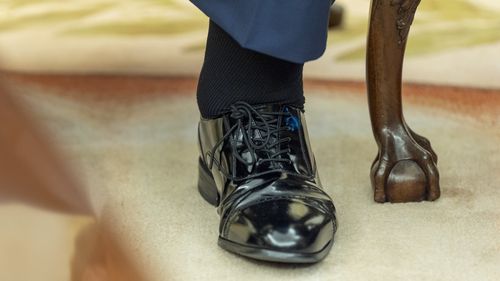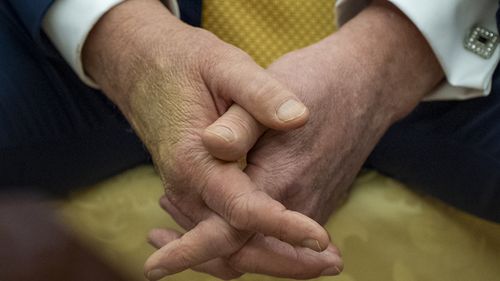Share this @internewscast.com
According to press secretary Karoline Leavitt, Trump, aged 79, underwent a thorough examination with the White House Medical Unit, which included diagnostic vascular studies. These details were provided in a note by the president’s physician, Captain Sean Barbabella.
Barbabella’s report indicated that “bilateral lower extremity venous doppler ultrasounds were conducted and diagnosed chronic venous insufficiency, ICD-9, which is a common condition, especially among those over 70.”

The examination came after Trump had “noted mild swelling in his lower legs” over recent weeks, Leavitt said.
Leavitt conveyed from Barbabella’s note that there were “no signs of deep vein thrombosis or arterial disease,” and all of Trump’s laboratory results were “within normal limits.” Additionally, an echocardiogram revealed “no signs of heart failure, renal impairment, or systemic illness.”
Chronic venous insufficiency is a condition in which valves inside certain veins don’t work the way they should, which can allow some of the blood to pool or collect in the veins.

About 150,000 people are diagnosed with it each year, and the risk goes up with age. Symptoms can include swelling in the lower legs or ankles, aching or cramping in the legs, varicose veins, pain or skin changes. Treatment may involve medication or, in later stages, medical procedures.
“It’s basically not alarming information, and it’s not surprising,” said Dr Jeremy Faust, an assistant professor of emergency medicine at Harvard Medical School.
“This is a pretty normal part of aging, and especially for someone in the overweight to obese category, which is where the president has always been. But the bigger concern ⦠is that symptoms like this do need to be evaluated for more serious conditions, and that is what happened.”

Leavitt later added that the president was experiencing “no discomfort.” She deferred to a forthcoming letter from Barbabella regarding treatment for the condition.
The press secretary also addressed bruising that has appeared on the back of the president’s hand, which she attributed to his “frequent handshaking,” plus his use of aspirin.
“This is consistent with minor soft tissue irritation from frequent handshaking and the use of aspirin, which is taken as part of a standard cardiovascular prevention regimen,” Leavitt said, via Barbabella.
Trump will become the nation’s oldest president during his second term.












